Legacy Systems Modernization: Trends and Predictions
Discover the latest trends and predictions for modernizing legacy systems and learn how it can benefit your business to stay one step ahead.
Join the DZone community and get the full member experience.
Join For FreeLegacy systems, despite their outdated technology, continue to be the backbone of many organizations' operations. However, with the increasing demand for digital transformation, companies now realize the need to modernize these systems. Modernizing legacy systems involves upgrading, replacing, or integrating old technology with new, more efficient ones.
This process enhances an organization's efficiency and improves its competitiveness in the market. Organizations may take help from a cloud services provider to make it effortless.
This blog will explore the latest trends and predictions in legacy system modernization.
We will explore emerging technologies and how they shape legacy system modernization's future. By the end of this blog, you will better understand the current state and the future of the legacy system and how it can help your organization stay competitive in the digital age.
Future Trends in Legacy Systems Modernization
Several legacy system modernization trends are shaping how organizations approach this process. Here are a few of the most notable ones.
1. Cloud Migration

Cloud migration involves moving legacy applications and infrastructure to cloud-based services like Amazon Web Services (AWS), Microsoft Azure, or Google Cloud Platform. This shift offers several benefits, including improved scalability, agility, and cost savings.
By getting assistance from a cloud services provider, organizations can quickly scale up or down their resources to meet changing demands and pay only for what they use. Organizations can use cloud migration services to use modern technologies, such as serverless computing, containerization, and managing databases.
2. Microservices Architecture

Microservices architecture is a modular approach to software development that involves breaking down monolithic applications into smaller, independent services. Each service focuses on a specific business function and can be developed, deployed, and scaled independently. This approach enables organizations to iterate and innovate faster, reduce time to market, and improve resiliency and scalability. However, microservices architecture also comes with challenges like increased complexity, distributed architecture management, and communication overhead.
3. DevOps Adoption

DevOps focuses on the collaboration of 2 teams: operations and development. The main focus is to streamline the software development and deployment process. This approach involves automating manual processes, continuous integration and delivery, and monitoring and logging.
DevOps adoption can help organizations reduce software development cycle times, improve quality, and increase the reliability of software releases. However, it also requires a significant shift in organizational culture and mindset and may require investments in tooling and infrastructure.
4. API Integration

API integration exposes legacy system functionality through APIs, allowing other applications to access the needed data and services. This approach can help organizations create new applications and services without replacing legacy systems entirely.
API integration enables organizations to improve data sharing and collaboration between applications, reduce development and maintenance costs, and provide a better user experience. However, API integration requires careful planning and design to ensure the APIs are secure, scalable, and maintainable.
5. Artificial Intelligence and Machine Learning:

Artificial intelligence (AI) and machine learning (ML) enable computers to learn and make decisions without direct human intervention. These technologies can be applied to legacy systems to automate and optimize processes, improve data analysis and insights, and enhance customer experiences. For example, they can be used to automate customer support, detect fraud, predict maintenance needs, and improve supply chain management. However, implementing them in legacy systems requires careful consideration of data quality and privacy and may require significant investments in infrastructure and expertise.
What Are The Predictions For Legacy System Modernization?
Legacy system modernization has been a hot topic in the technology industry for several years, and its importance is only increasing with the rise of digital transformation. Here are a few predictions for legacy system modernization:
1. Increased Demand for Legacy System Modernization
As businesses evolve and adapt to the latest market conditions and individual needs, the demand for legacy system modernization will continue to increase. Legacy systems often cannot keep up with technological change, so modernization efforts will be essential to stay competitive.
2. Focus on Cloud-Based Solutions
Cloud-based solutions will be a key focus area for legacy system modernization efforts. Cloud-based platforms offer greater scalability, flexibility, and cost-efficiency than traditional on-premises systems. Organizations can leverage cloud solutions with a cloud services provider for greater accessibility, enabling remote workforces and distributed teams to collaborate more effectively.
3. Emphasis on Data Analytics and AI
As organizations modernize their legacy systems, they increasingly focus on leveraging data analytics and AI to gain insights and improve decision-making. Legacy systems cannot often handle large volumes of data and process it in real time. Modernizing legacy systems with advanced analytics and AI capabilities can help organizations derive greater value from their data.
4. Continued Investment in Modernization Efforts
Legacy system modernization is a complex and resource-intensive process, but it is critical to maintaining competitiveness and meeting the needs of customers and stakeholders. As such, organizations will continue to invest in modernization efforts to ensure that their systems remain up-to-date and capable of supporting their evolving business needs.
Wrap Up!
In the coming years, we expect to see an increased focus on legacy system modernization as organizations seek to remain competitive in an ever-evolving digital landscape. The trends in legacy system modernization are shifting toward technological advancements. By adopting these leveraging emerging technologies, organizations can stay ahead of the curve and meet the changing needs of their customers.
Opinions expressed by DZone contributors are their own.

Comments